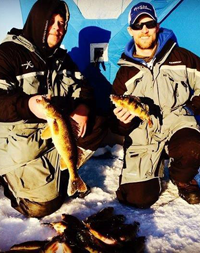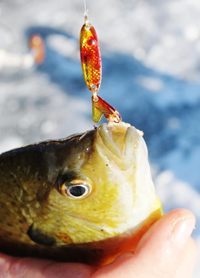 (4/24) Greg Clusiau, "Greg's Guidlines" - Spring Boat Prep (4/24) Greg Clusiau, "Greg's Guidlines" - Spring Boat Prep
Courtesy of Mike Niedzielski, HSM Outdoors Contributor
Getting your boat ready for the first time on the water can save you a lot of headache. Everyone has either seen or been that person that launches their boat, only to find out they have a dead battery or it just will not start. Obviously it is quite frustrating for the boat owner but it’s just as big of a headache for other people waiting to load or unload behind you at the access. Taking a few minutes to complete these simple steps can save you a lot of time and money on repairs that could have been prevented.
I like to start with the most common issue, the batteries. Clean all corrosion from connections and terminals. Make sure all batteries hold a charge prior to the night before your first trip. It is good practice to keep them on a battery tender in the off season, or periodically charge them each month when not in use.
Check over your motor for any damaged wiring or rotted air and fuel lines. Even the smallest crack can cause big issues in the performance of your motor. Next, you will want to check your spark plugs for any damage or abnormal coloring on the firing ends. Not sure what you are looking for? What is considered to be acceptable in appearance is brown to light gray, otherwise replace.
Raise and lower your trim to make sure it is in proper working order. If it’s weak or not moving, the brushes may need to be replaced. Inspect the lower unit and prop for any cracks or other damage. If you didn't change your lower unit oil in the fall, make sure to do so now.
Next you’ll want to connect a motor flusher, also commonly known as “ear muffs”, to the garden hose. Slide the “ear muffs” over the water intake and turn on the water supply. Always add fresh gas if you can, even if you added fuel stabilizer in the fall. Even fuel stabilizer can break down over time so fresh gas is always recommended. Always try and use ethanol free gas. Ethanol can cause gaskets and rubber in the carburetor to rot over time, causing premature failure. Saving a few pennies at the pump can cost you much more over the long run.
Squeeze or prime the gas line. Choke and turn the key. Now remember, it may take a while to get it to fire off at first. It can take a few tries as the bowls on the carburetors need to fill up. Take care not to flood your motor. Once started, make sure the water pump is working and a strong stream of water is coming out. Let the engine warm up for 2-3 minutes. Then make sure it engages in both forward, and reverse. Once you’re certain that it is in good running condition, kill the motor. Again inspect the motor for any fuel leaks. If all is good, re-install the motor cover.
Afterward, check all gauges, navigation lights, and switches. Live wells and bilge pumps are often overlooked. Make sure your pumps all turn on and work. I had an incident last year while on the river. For some odd reason my boat was filling up with water and I had no idea where it was coming from. Thankfully the bilge pump worked and I was able to make it back to shore to inspect the boat immediately. To my surprise the live well pump somehow got a crack in the housing. This was causing the water to start siphoning into the hull below the floor. That was a first!
Don’t neglect your trailer, without it you’re not going anywhere. I see a lot of people driving with burnt out or broken lights. Inspect any burnt out bulbs or broken lenses and replace. If you are still having issues with trailer lights look at the connection, you may have corrosion that needs to be cleaned off. One other possibility is a short in the wiring. You have lights for a reason so make sure they work!
Inspect the tires for abnormal wear. Uneven wear can be caused by something as simple as tire pressure. Check your wheel bearings for any play by simply wiggling the wheel left to right and top to bottom. If you do not have “bearing buddies”, I suggest investing in some. This simple product will make greasing your hubs quick and painless.
Take a little time to go over your boat before you dip it in the water for the first time. Doing these few simple things will not only give you a peace of mind everything is operating correctly but can also ensure the safety of yourself and others. Don’t be “that guy” holding up the boat launch!
 (4/20) Greg Clusiau, "Greg's Guidlines" - Hot Springtime Crappie Bites (4/20) Greg Clusiau, "Greg's Guidlines" - Hot Springtime Crappie Bites
Tom called. He had the weekend off and wanted very much to get into some ice-out panfish. Living in Ontario, his fishing season had come to a close as far as ice fishing went and he wanted to get into some ice-out crappie or bluegill. “Sure” I responded, “let’s do it.”
Having spent a little time with me during last year’s ice-out period and catching a bunch of gills, Tom Batiuk wanted more, as sunfish aren’t very plentiful in “Sunset Country.”
He messaged me on a Friday night saying “I'll be on the road at 5am. Meeting at the A-Frame?” That message had me hurriedly messaging him back saying “We can meet there but you may want to leave a little later, like 7:00 am so the water has a chance to warm.” He was talking of the cabin on Little Bear Lake, in Minnesota’s Itasca County, where we have previously met for various fishing excursions.
Plans went accordingly and when I pulled into the cabin yard Tom was already giving the shoreline a good working over.
Walking down to see how he was doing, I checked the water temp and found it to be a cool 50º. Two days earlier, I was checking temps and found it to be over 52º.
In 10 minutes of casting, the only bite Tom had received was from a hungry northern pike, which bit him off.
Overcome by a bad feeling of fishing failure, I told him “the water’s too cold for the fish to be up close and active.” His quick response was “let’s go visit Chad.” I agreed. It was a good call. If there was anything wrong with that decision it was the fact that our good buddy Chad lived in Alexandria, some 250 miles away.
Never-the-less, there we were, back in Keewatin, piling all essential panfish gear into Tom’s new diesel truck and heading south, another 4 hours, where the water temps would be much warmer and panfish would be a whole lot more predictable. I’ve always said and stand by the fact that in order to stay on fish and enjoy a good bite one has to travel, something that I’ve been preaching and doing for decades.
Day trips of 500 miles or more are something that I’ve accepted when it comes to staying on fish. As a matter-of-fact, back in my guiding days I boasted of fishing a 1,500 square mile area in northern Minnesota, traveling to wherever the hot bite happened and that’s just what I did. I continue to use this method today.
We messaged Chad Peterson, aka “the crappie sniffer”, who when first receiving our text thought we were just playing with him. Who in the world says “we’re heading your way for some fishing” and it’s mid-morning and you are over 200 miles away? The answer: Greg Clusiau and Tom Batiuk.
Pulling into his driveway, Chad was standing outside next to his boat, looking a bit disgusted, because we were late, like it was just a drive across town. It was late, I’ll give him that. After all, here we were, arriving at his place, in southern Minnesota, at 2:00 pm and expecting to get in on some good fishing to complete the day.
Quickly throwing our gear in his truck, we sped off to the first lake, which proved to be a bust, with water temps being a little too cool for his liking. “Oh boy” I thought. Here we were over 2oo miles from home in the late afternoon and expecting to get in on a good bite. One, however, has to realize that Chad “is” the go-to guy when it comes to panfish. We didn’t drive that far for our health. We wanted fish!
The next lake proved to be the gem. Chad had five lakes lined up but we needed to go no further, as nearly every cast produced a sunfish or crappie. They were located in a shallow, weedy, back bay that received a lot of sunlight and the water temperature was measured at a scalding 58º. Imagine that. Drive over 200 miles south and find water temps 8º warmer. That’s “all” it took to find fish and hungry fish at that.
We didn’t keep track but an honest estimate of approximately 200 panfish were caught and released on this day. Yes, it does pay to travel to the next hot bite.
 (4/15) Greg Clusiau, "Greg's Guidlines" - Rainy River Wrap Up (4/15) Greg Clusiau, "Greg's Guidlines" - Rainy River Wrap Up
The last two fishing trips for me were both on the Rainy River and 2 ½ weeks apart. I normally never have that much “down time” between trips but after making two trips into Canada for crappie and one to the Rainy River for walleye in a span of five days I got a little tired out and came down with a terrible cold, which basically rendered me home bound for the entire time. I haven’t been that sick in years, if ever.
I can tell you this and that is my garage has never looked so organized, as that was about all I did during my sick leave. A couple of winter fishing rod racks were made too.
The big switcheroo was done last weekend, taking all of the summer stuff out of storage and putting all winter equipment in. How nice it is to have the boat sitting in the garage, waiting for me to get it water ready, which if in a hurry would only take a half hour or so.
All we have to do now is wait for open water and by the looks of it is not too far away. My brother called to say Little Bear Lake was ice free, which is really early for that lake. Usually, other lakes are opened up before that one.
As far as fishing goes, friends are already catching open water crappie in the Alexandria/St. Cloud/Brainerd areas. All we have to do is wait another week for our North Country lakes to shed their winter coats and we’ll be out there as well.
Driving up north, I went past the Buck Lake public access on highway 65 and spotted five deer standing on the ice, looking for a way off the lake. They were looking a little nervous, as the shoreline was wide open.
They can swim just fine but if they happened to fall through the rotting ice I’m not sure they would have made it. Finally, a large doe found a safe spot to jump to shore and the rest quickly followed behind. It was nice to see. At first, I thought I may be witnessing a tragedy, so I made sure to stay well away from them to prevent spooking.
The Rainy River walleye season has now closed but for those wishing to hop in the boat and get bit the sturgeon fishing is currently going well and you have until May 7 to get in on the fun. If you ever wanted to catch a truly big fish, this is your chance.
It is catch and release only through April 23 with a special harvest season from April 24 – May 7. Anyone planning on keeping one (only 1 per calendar year) must plan accordingly and have a sturgeon tag on hand, which must be validated and attached immediately upon catching the fish and registered within 48 hours. The sturgeon must be 45” – 50” inclusive or over 75” in length. Frankly, I have no desire to keep a big fish like that, preferring to let them go, but to each their own.
After the harvest season, catch and release is allowed from May 8 – 15 and no tag is required. The sturgeon season then remains closed from May 16 to June 30.
For those still wanting to feel a tug on the line but don’t have the time or means to fish the Rainy River, head over to the local river for a crack at a few suckers. This is fun and something I used to do every year, sort of like a spring ritual. Yes, I like to fish for practically everything that swims and suckers are on the list.
I found it a good way to get a few rods and reels ready for the general opener, as I would use a couple of my walleye rods, rigged up in live bait fashion with a slip sinker and leader with a plain hook. I’d always catch and release but they are good smoked and a lot of folks keep them for this application.
It’s happening now. Get out there and have some fun.
 (4/7) Greg Clusiau, "Greg's Guidlines" - Sturgeon 101 Courtesy Andy Walsh (4/7) Greg Clusiau, "Greg's Guidlines" - Sturgeon 101 Courtesy Andy Walsh
It’s that time of the year to get into the prehistoric giants that lurk the depths of Rainy River.
Water temp is roughly 37-38 degrees with this current cold front and water clarity is roughly at 3 feet. Facing a 10-12 mph NW wind all day, we managed to catch 11 sturgeon ranging from 60.5 inches down to 20 inch class.
Sturgeon fishing is a chance for family and friends to get together and fish for giants and grab some quality time away from the digital world. Here are some tips to help you get in on this exciting fishery.
First off, catch a photo- it'll last a lifetime.
When handling these fish don't put your hands in the gill plates or hold them vertically. I can admit when I first fished sturgeon I learned this was very harmful on these fish. Hold them with two hands at a horizontal position.
Here’s a countdown of top ten tips to catching a sturgeon on Rainy River:
10. Don't be cheap on crawlers- fill that number 5/0 circle hook with a generous gob.
9. No-roll weights need to be proportional to the current. Recently, 4oz no-rolls have been perfect.
8. Use about a foot of heavy braid line for a leader. Using more puts your hook at risk for not being on the bottom where it needs to be.
7. Use the clicker function on your bait caster to its fullest. Utilizing this will allow you to keep the reel in free-spool versus loosening your drag, so the fish can run with the bait. Make sure your drag is set for them to run. And let them run! Their mouths are strong but hooks can tear out pretty easily. Losing a fish because of poor drag can cost you a day without getting any sturgeon.
Keep an eye on the rod tip. With lower current or bigger fish, they may just suck the hook in and stay put. You will see your rod tip bounce pretty good in this case because the weight it picked up off the bottom.
6. As obvious as it sounds - keep your line in the water. Being patient is key here. Sturgeon are bottom roamers and will eventually find your gob of worms. Many boats around us were constantly reeling in and casting without much luck. Patience is key.
5. Boat position. When fishing current plus an opposite wind, it’s key to position your boat so you don't move or pose a risk of the anchor letting loose. Being and staying in the spot that you plan to be is essential. Floating around chances your big rig for instant rock snag. Staying in one spot also sets up everyone so the lines can stay spread out and tight.
4. Get a big rod with a back bone. I use my musky set up. (Makes it multifunctional and cheaper on the wallet to not go buy more rods.). I actually like to use my St.Croix for the strength and quicker retrieval. I also have an Ugly Stick which is fun because it feels like an "ultra light" for the fun fight. Something worth noting: bigger equipment to get these majestic lurkers of the deep is better on the fish in regards to their recovery. The longer the fight the more lactic acid build up which is harmful on any fish. These sturgeon fight current and need all the strength the can get after a good fight.
3. Electronics and mapping. This takes a lot of guessing away when picking a spot. Going on a gut feeling may not cut it. Finding holes are good spots to start because it seems they like the deepest parts of each segment of river. Don't always trust mapping. Water levels, sediment, and debris will fill prior spots. Using side imaging along with down imagining helps find the nooks and crevices that sturgeon like to stay in.
2. Don't fish alone if you don't have too. Sturgeon fishing is a team effort. One to catch. One to net. And really, one to pull anchor if needed. We find that three in the boat is a good number, plus it adds extra lines to explore different parts of the "hole" you are fishing. It also makes unloading and loading your boat very quick!
1. Homework and perseverance. If you go for the day or weekend, don't get down on yourself if it doesn't pan out right away. Give an area an hour or two and move if things aren't working out. Even if you come back a year later to your "spot". It will be different because rivers constantly change.
This year the water was way below last year’s level so be careful when navigating. Mapping systems in a river are very close and relative with their contour lines, but can't be relied upon solely. Take notes of temp, water clarity, water temp, and weather. It'll all add up in the end.
Putting these 10 tips together will give you a better chance and understanding from the get go. Putting time in will increase your numbers. Be comfortable! It's a waiting game. Stay warm and relaxed.
As always. Fish smarter... Be a Fish Head. Andy (article courtesy of Andy Walsh) .
 (3/31) Greg Clusiau, "Greg's Guidlines" - Rainy River Walleye Fishing (3/31) Greg Clusiau, "Greg's Guidlines" - Rainy River Walleye Fishing
Ice fishing was still going strong when I jumped in the boat for the first time this spring and that happened a week and a half ago on the Rainy River. I’ll blame fishing partner Justin Bailey for that one. Well actually, I usually never need any arm twisting but certainly had my doubts of a fun trip when the thermometer read 32º while on our way up there. It was going to be cold, to say the least.
The river had supposedly opened up past the Birchdale public access. Again, I was doubting, as heading east toward the access, the river was covered with ice. I asked Justin “are you sure?” He just laughed. It was he who received the fishing report of good catches and an ice free landing. It was his gig. I had to trust him. Finally, ice floes and patches of open water greeted us about four miles from the boat launch.
Being midweek it wasn’t too busy, compared to what it can be. We were, however, there at first light and well ahead of most other early spring walleye hopefuls.
I heard reports of a shuttle service of sorts where, for a small fee, someone would drive to the end of the parking area and pick you up with a golf cart. That’s a great idea, as when things get going on the Rainy River, parking is at a premium and the walk back to the boat can be quite a distance. Early birds that we were, the mini transport wasn’t available.
The river was low and current somewhat slow, making for good fishing conditions. Most all snow had melted away and it was an entirely different scene than what I was accustomed to when it comes to spring fishing on the Rainy.
Normally, water is heavily stained and rushing past the ramp with a strong presence. One also had to be mindful of the Little Fork and Big Fork rivers, as when they “let go”, fishing could very possibly come to a halt due to a lot of extra ice and rising muddy water. Not this year. This would be a “walk in the park” as long as we didn’t hit any rocks.
Bundled up, more than we would for ice fishing, it didn’t take long to put a nice walleye in the boat. Looking to be somewhere in the 22” range and caught by the third angler in our group, Ben McInerney, it was quickly admired, photo’d and gently eased back into the river.
Special regulations apply to the Rainy River during this time and that means any walleye measuring 19 ½” or longer must be released. This means “pinching” the tail down to get as long a length as possible and the limit is two per person.
So if you want to load up on a bunch of fish to take home, the Rainy River isn’t for you. However, if you want to catch a bunch of walleye and have a chance at a big one, perhaps it’s just right. Most anglers, like us, just wanted to get out on the river for the first time this spring and catch an open water fish, no matter how good the ice season was. That first open water jig bite is something special indeed.
This early bite also gives one a chance to see how everything operates (outboard, trolling motor, graph, live well, etc.) in preparation for the Minnesota general fishing opener on May 9.
It took some time before the air temperature finally warmed up and by that I mean it may have hit 45º on this day. It certainly didn’t feel like it though.
For most of the day the water temperature, measured at 36º, was warmer than the air. I told the fellas to stick their hands in the river if they were cold. No takers.
Fishing wasn’t fast and furious by any means but remained steady enough to keep us interested. We ended up catching a couple dozen walleye, bringing home six.
Best baits were jigs and minnows or jigs and plastics. Justin was hot using a variety of presentations and usually caught a fish on the very first cast after tying on something new. It was kind of comical. Justin catching five small northern pike was funny as well.
Occasional sturgeon were accidently hooked. We watched an angler battle one for over fifteen minutes before it came unbuttoned near the boat. He never saw the fish but was leaning into it for all his eight pound test line could take.
There’s a lot of fun taking place on the Rainy River right now. The spring walleye season goes through April 14. Get up there and give it a whack.
 (3/24) Greg Clusiau, "Greg's Guidlines" - Fast Forward >> Back To Winter (3/24) Greg Clusiau, "Greg's Guidlines" - Fast Forward >> Back To Winter
I should have known that the so-called “first day of spring” would send us right back into winter mode, which is just fine for me, as the ice fishing season has been extended another week or two.
Looking for stronger and perhaps even safer ice, Blake Liend and I made a couple recent trips across the border to join fishing guide Tom Batiuk of Ft. Frances. Tom is all over the place up there and usually has the fish wired. Being a pilot and flying frequently, the observant Batiuk notices where people have been fishing and better yet where they haven’t. This is where we come in.
Crappies were our target and find them we did. We used atvs, even though trucks were still driving around on areas of Rainy Lake last weekend. I don’t know about that. It scares me. Yes, there is still about 36” of ice but it is late March and nearing the end of a season. Also, many of these Canadian Shield lakes have a good amount of current running through them. This is always something to be concerned about, especially when traveling or fishing near “pinched down” bottleneck areas.
Crappies were doing their thing, moving about and heavily feeding. Coming and going, they’d appear below you and aggressively bite if you were quick enough to get your lure in front of them. I believe there are a couple factors that have these fish on the move. One, they are chasing bait and two, they themselves are bait to northern pike.
Everyone has their own special baits and Northland Tackle’s “Forage Minnow” spoon is one of mine, all winter long. It just so happened, on the first trip, that one of these little spoons in “Glo Chub” color was the hot bait of the day and I was the only one who had one. Imagine that.
Oh what fun it was, razzing my fishing companions with each big crappie pulled through the hole. Hey, I’ve been there, on both sides of this dilemma, so when you get your chance to put on the dog, go for it.
On the way out to our second outing, I told my comrades that I was just going to set up shop in my Fish Trap, back to the wind and sun, take photos and cook.
Stopping on the fishing grounds, a hole was courteously drilled right in front of the “cook shack.” These guys really take care of me. However, when I spotted fish below me I just had to drop a line and after catching four quick slab crappie, the good-natured banter began. At this point, I dug out the tinfoil and brats and got to cooking lunch.
In between cooking, I walked around taking a few photos, catching a fish or two. It was a good bite, real good. Blake reeled in an oversized slab that coughed up a small crappie. Yes, they do eat their own, like most all fish, as long as the size is right. It’s a tough, cruel world down there.
This got me to thinking “I wonder if I could catch a monster slab on a lure replicating a small crappie?” Digging through my tackle bag, I pulled out a Clam “Psycho Shad” and dropped it down. “Chartreuse/Shiner” in color, it was a nice and bright for the stained water we were fishing and of the perfect size, ideally “matching the hatch.”
The lure was quickly intercepted on its descent by a big crappie. It was working.
After catching several nice fish with the bait, I wondered what else would work and once again sorted through the tackle bag, coming away with a small Northland Tackle “Rippin’ Shad” in “crappie” pattern. An exact replica of the little crappie, in both size and color, I was excited to see how it would perform.
However, this one too was greeted on the first drop but this time it was a northern pike. Needless-to-say, the lure was gone in four seconds and it was time to re-tie.
The next selection was one of my favorite lures for monster Lake Winnipeg walleye, an orange and glow Salmo “Chubby Darter.” I fished for an hour or two with this bait and caught several fish until once again being bitten off by a northern. Switching back to a Forage Minnow, I finished the day.
Moral of the story? Don’t be afraid to experiment, especially when the fish are biting. You just might find a new technique or two. - Good luck, be safe, and have fun.
 (3/16) Greg Clusiau, "Greg's Guidlines" - Soft Ice Says Goodbye to Ice Fishing, Almost (3/16) Greg Clusiau, "Greg's Guidlines" - Soft Ice Says Goodbye to Ice Fishing, Almost
Another ice fishing season is fast coming to an end and it’s hard to believe, actually frightening, that trucks were driving on the ice up until last weekend. Actually, some of them broke through on various lakes across the state, as well as in the North Country.
Oh sure, there was plenty of ice, up to 3’ or more, but when my auger cranks out a hole in a matter of seconds, with near dull blades mind you, it’s time to start using other modes of transportation.
The speedy hole drilling is a result of soft ice. Having the same blades on my auger since new, two years ago, means they definitely aren’t as sharp as they used to be. I noticed a difference during late winter when the ice was still solid. I could cut a hole alright but it just wasn’t the same, which means I’ll be sporting new blades next November.
I will say one thing and that is I am quite satisfied with my Clam Edge auger, as it starts on the second or third pull in the morning and on the first pull thereafter throughout the day. It also cuts like a mad chicken, if you can imagine that??!
I’ve seen a lot of “rotten” honeycombed ice in my day but the large chunks coming out of the hole last Sunday were amazing and to see vehicles driving on top of this stuff even more so.
Walking, I pulled my Fish Trap packed full of gear, actually more than I really needed, and even though it was a half mile or so the sled pulled with ease as there wasn’t any snow to slow me down. All glare ice made for easy walking but you had to wear ice cleats.
Many of the holes were wide open from the day before so searching for fish was made easy too. Using my Vexilar, all I had to do was walk around and drop the transducer in several of the many holes until fish were spotted. Then it was time to get to work.
The fish were really on the move on this day, which more than likely meant they were heavily feeding. Many times, I wasn’t quick enough in getting the lure down to them and they would vanish before I had a chance to catch one. However, if fortunate enough to reach them before they left, a bite was immediate, as several fish at a time were on the screen.
Extreme caution is advised, even if walking. I plan on going a few more times but not too much in this area. I might make a trip or two to visit friends in Ontario, where the ice is in slightly better shape.
Looking at my fishing log, I have been ice fishing 88 times this season and while that may seem an incredible number I don’t think the ice will last long enough for me to reach 100, which I did a few years ago and I was working a fulltime job back then. How was that even possible? I remember fishing 100 days on open water and 100 days on the ice that year. I must be slowing down.
I had to laugh, last Saturday, as I made my regular morning stop at the Keewatin Sinclair convenience store. It was here that I bumped into two of my nephews, who were going fishing. What else? They were heading up north to fish with one of my brothers.
Another brother was thinking of going to a different lake and my son and another nephew were on their way to Lake of the Woods. Also, my son-in-law invited me to fish with him in the Big Winnibigoshish/Bowstring area. I guess we love the outdoors, as this close-knit family does a lot of hunting as well. Pretty cool.
What do they say? A family that fishes together sticks together? Or something like that. Get out there and enjoy the outdoors. It’s happening NOW.
 (3/9) Greg Clusiau, "Greg's Guidlines" - Ice Fishing Lake Winnipeg Walleye (3/9) Greg Clusiau, "Greg's Guidlines" - Ice Fishing Lake Winnipeg Walleye
Another Lake Winnipeg walleye trip is in the books and what a trip it was. It did, however, start out slow but steadily picked up steam with each new day. The weather also continued to improve, which more than likely had something to do with our success in catching portly Lake Winnipeg walleye.
Based out of Gimli, on the west side of the massive lake, we stopped to fish on our first of four days before driving further north to register at Lakeview Resort. Gaining access through the Chalet Beach area, we parked on the lake and used snowmobiles to reach our destination, several miles away.
Lake travel was extremely rough and rarely could a top speed of 15 mph be reached without destroying fishing equipment stored in our portable Clam shelters.
Sub-zero temperatures had me wishing I had a heated face shield on my snowmobile helmet, as by the time we arrived at the fishing grounds, some thirty minutes later, I had frost and icicles on my eye lashes. It was bitter out and gusting winds didn’t help matters.
Only seven fish were caught by seven anglers for our first half-day on the lake. It was slow, to say the least. On the plus side, due to a lack of snow, truck traffic seemed to be the preferred mode of transportation and snowmobiles wouldn’t be needed for the next three days. This would make for easier and much warmer travel.
When planning for the trip, we always check lake conditions just to make sure we’re doing it right. I would hesitate in driving that far without an optional mode of transportation. You have to be ready for most anything. Even though the snowmobiles were left at the resort, if an unexpected snowstorm came to visit we would still be able to do our thing.
Each morning started with a pit stop at the local gas station, where travel mugs were filled with steaming hot coffee and containers of frozen minnows were purchased. Evidently it was the place to be as anglers stood in line for each.
Truck travel was sweet but not any smoother. It was terribly rough out there and I was glad the ride wasn’t any further. Traveling in convoy style, the lead vehicle would break trail while the rest followed. If stuck, which only happened a couple of times, tow straps were used to continue on.
Pressure ridges were encountered from time-to-time and crossing them meant slowly following a rutty trail already there. Some were obstacles in the form of rough and bumpy ice which required a slow speed. Sometimes you had to “give it” because of a rutty, deep snow trail. Other than that, travel went smooth and we could fish anywhere we cared to.
Day two was better but still somewhat slow in numbers of fish caught. Size, however, was there and several “Masters” were achieved, which meant the fish measured at least 28”. First time Winnipeg angler Andy Walsh bagged two of them, measuring 28” and 30”. The largest weighed in at 11 pounds 12 ounces and made its way to Chris Kunze Taxidermy in Keewatin. Andy’s brother, Mike, another Lake Winnipeg first-timer, followed up with a 30” of his own on the very next day. That one too will be hung on the wall.
Mike Walsh, Executive Chef at Streetcar Kitchen & Pub in Carlton, MN prepared lunch for us out on the lake in a large Clam hub shelter. Imagine piping hot walleye chowder and fish tacos out on the ice. That sure hit the spot on those cold days.
I may have started out slow in the catching category but ended up with four of our groups twenty Master fish, with three 28” and a 29”. These fish are just incredible and even though I have made eight trips to this big walleye wonderland, I find myself duly impressed with each outing. Words can’t explain, much like the world class channel catfish fishing in the Red River that flows into Lake Winnipeg. Amazing.
Best baits pretty much depended on what you used the greater percentage of the time but top producers for us were “Rippin’ Raps”, “Clackin’ Raps”, “Rippin’ Shads”, “Psycho Shads”, and “Slender Spoons”.
It’s all happening right now and you owe it to yourself to give these fish a try. It’s truly an amazing fishery.
 (3/3) Greg Clusiau, "Greg's Guidlines" - Bigger and better would appropriately describe the annual “No Child Left Inside” program put on by the Nashwauk-Keewatin schools where all students from 4th to 6th grades are allowed to head to the lake for a day of outdoor fun. (3/3) Greg Clusiau, "Greg's Guidlines" - Bigger and better would appropriately describe the annual “No Child Left Inside” program put on by the Nashwauk-Keewatin schools where all students from 4th to 6th grades are allowed to head to the lake for a day of outdoor fun.
Brainchild of elementary teacher Chris Lysaker, last year’s event was canceled due to poor lake/weather conditions but this year was a smashing success with even more to offer the students, some of which have never had a chance to enjoy the great outdoors before in this capacity.
An avid angler, it is quite obvious that Lysaker would involve a little ice fishing to the program. Actually, there is a whole lot of ice fishing along with many other outdoor activities available the students like snowshoeing, sled dog rides, snowmobile sled rides, and just plain playing on the lake.
Local law enforcement agencies and fire departments were on hand, along with the Life Link helicopter, allowing students to understand and appreciate just how much effort goes into protecting our communities.
One new addition to this year’s outing was the Iron Range Chapter of the Minnesota Darkhouse and Angling Association. An exciting winter pastime, students could go inside a portable shelter and experience what it looks like to spear or sight-fish in a large hole that offered a great view of the lake bottom.
Angling was slow on this day but it was apparent that all children had their fair share of fun in trying to catch a fish. One young girl exclaimed “I want to catch a fish through the ice, I’ve never done that before.” She did.
Crappie Action Heating Up…Crappies, and some nice ones at that, have been more than willing to bite as of late with several area lakes producing some very nice fish and lake travel with vehicles continues to be a great option for getting to your favorite fishing hole. Yes, it’s been quite a winter.
Remember, a new Minnesota angling license is required and walleye and northern pike seasons have closed until opening day. You can, however, continue to catch stream and lake trout through the end of March.
Keep in mind the ice house removal date of March 16, when all shelters have to be off the lake each night unless attended. This applies to the areas north of highways 10, 34, 200, and 2.
Area Fishing Guides Offer Good Fishing…Grand Rapids area fishing guides Zach Dagel of Grand Rapids Guide Service and Reed Ylitalo of Wings and Walleyes Guide Service have been doing very well on the panfish. March is a great month for catching these fish and it will only get better as the season progresses. Anyone interested in spending a quality day on the ice learning and catching should really consider contacting one of these gentlemen.
For those wishing to catch a lake trout, consider lining up a trip with Ely fishing guide Steve Foss or Effie’s Lee Lane. These guys catch fish and March can be “prime time” for lake trout fun on Burntside Lake. It’s also a little warmer out and lake travel mush easier.
Still Want Pike and Walleye?...Well if that’s the case, you may want to head north and fish Lake of the Woods, where the walleye season runs through April 14 and the northern pike season never closes. Many anglers try their hand at a big northern pike during this period and many are caught. If you’re looking for a trophy, now is the time. Good luck, be safe, and have fun.
 (2/23) Greg Clusiau, "Greg's Guidlines" Fishing With Vets On Lake Winnibigoshish Part 2 - They came from far and wide, veterans all, from different walks of service life. Some active, some fresh off a tour to Afghanistan or Iraq, or both. Others experienced Viet Nam. It didn’t matter because this time they were gathered together for a different cause, to experience the flavor of ice fishing in northern Minnesota. (2/23) Greg Clusiau, "Greg's Guidlines" Fishing With Vets On Lake Winnibigoshish Part 2 - They came from far and wide, veterans all, from different walks of service life. Some active, some fresh off a tour to Afghanistan or Iraq, or both. Others experienced Viet Nam. It didn’t matter because this time they were gathered together for a different cause, to experience the flavor of ice fishing in northern Minnesota.
The newly founded organization “Fishing with Vets” honors all veterans and is proud to take them fishing, whether open water or on the ice, which it was three weeks ago on Big Winnibigoshish, based out of High Banks Resort.
“Fishing with Vets” is the brainchild of Justin Grecco and Justin Bailey. Grecco, president of the organization, never served in the Armed Forces but puts his heart and soul into the project, honoring his grandfather who served in Viet Nam along with his great-grandfather who was in World War II.
Bailey, vice president, still has lingering effects from being wounded in Iraq but that doesn’t stop him from doing what he loves, fishing and helping out his fellow veterans. A humble Bailey said “it’s not about me. It’s about the veterans. Helping them out and having some fun.”
The Big Winnie outing entertained nineteen veterans in all. Some camped out on the big lake in wheel houses for the weekend, trying their hand at walleye and perch, while others ventured off to nearby waters in search of crappie.
A huge thank you goes out to local fishing guide Reed Yiltalo of “Wings & Walleyes” guide service for helping out and putting us “on fish.”
Not even two months old, “Fishing with Vets” is taking off in a big way and donations are rolling in. Clam Outdoors stepped up big time, like they usually do, along with Mills Fleet Farm and Hardees. Other sponsors were High Banks Resort and HSM Outdoors.
Several fishing guides have also donated trips for the upcoming summer season and they range from walleyes with Reed Yiltalo, bass with Brett McComas, lake trout with Tom Batiuk, and musky and sturgeon with Lee Lane. Any veterans interested in spending a day in the boat and joining in on the fun should go to the “Fishing with Vets” Facebook page for more info.
Thanks to all of the volunteers and sponsors who have made this possible.
 (2/16) Greg Clusiau, "Greg's Guidlines" Fishing With Vets On Lake Winnibigoshish - Just off the ice and writing this article on a Sunday evening, as early Monday morning will find me back in the Big Winnie area for the “Fishing with Vets” outing. Based out of High Banks Resort, two dozen veterans will be sampling the waters of Big Winnie, Cut Foot, Round Lake, and then some. It all depends on just where the best bite is happening and a full report will be given next week. (2/16) Greg Clusiau, "Greg's Guidlines" Fishing With Vets On Lake Winnibigoshish - Just off the ice and writing this article on a Sunday evening, as early Monday morning will find me back in the Big Winnie area for the “Fishing with Vets” outing. Based out of High Banks Resort, two dozen veterans will be sampling the waters of Big Winnie, Cut Foot, Round Lake, and then some. It all depends on just where the best bite is happening and a full report will be given next week.
Lake travel varies from lake to lake since our most recent snowfall. A prime example is Burntside Lake, where we drove pickup trucks all over in search of lake trout, is almost to the point where truck travel will be no more until it melts down sometime in March. Snow is fairly deep and drifted on this fun fishery.
Big Winnibigoshish, on the other hand, is just wonderful, with most all of the snow blown off the lake and pushed up along the shorelines. Cut Foot Sioux is rated somewhere in between.
I can tell you without looking back through my fishing log that the past week has been quite tough for me. Maybe I wasn’t fishing the best waters but never-the-less it was poor as far as production goes. I expected to do better.
Five different lakes each gave up a few fish and one of them even handed me a shutout. Of course, not much time was spent on the shutout lake, as I only fished for an hour before getting that gut feeling to pack up and get out of there. I could tell it just wasn’t going to happen and moved on to another body of water. Thank goodness for Itasca County and its 1,000 or more lakes.
The very last tight-lipped lake was Cut Foot Sioux, where panfish expert Crappie Keith Nelson and I threw everything in the book at lock-jawed crappie. Set up in a Clam “Jason Mitchell” 5000 Thermal hub shelter, we stayed warm on this blustery day and waited for fish to come through.
They were slowly coming and going and giving us the ultimate challenge with each and every visit. It wasn’t easy by any means and here we were teaching some of the Armed Services veterans the fine art of catching fussy fish through the ice.
I told one of the students “this is general as tough as it gets and if you can catch fish today you’ll be able to catch them anytime.”
Our presentation was to offer a small jig, with a dash of color, tipped with a wax worm or maggot. Keith and I both started out using Clam’s Maki plastics and Northland’s Impulse with nary a taker. Normally this is all one needs but this day was different, way different. They wanted “meat.”
Lines were light, in the 2-4 pound test and rods with a super-light wimpy tips or spring bobbers were used. They had to be.
Several times, a rod was placed into position and left on the ice, while other chores like rigging up other rods were tended to and more than once a fish was hanging on the end of the line when we picked up the rod. The fish were biting that light.
A tough, super fussy bite doesn’t bother me, as I love the challenge but when you have folks driving up from the Twin Cities or farther it would be nice if they could catch a bunch of fish. Maybe Monday. The weather’s forecasted to be in the teens and that might be just enough to get these dieting panfish to eat. Hopefully, after a week of fasting they’ll fall off the wagon and go on a real binge. We’ll see. It sure would be nice.
I should mention that I like to use wax worms or maggots when it comes to live bait for panfish but finding maggots on the Iron Range isn’t easy and the only place I have found them so far is at Thousand Lake’s Sporting Goods in Cohasset.
Maggots are more durable and have a tendency to stay on the hook better. They also come in a variety of colors! Stick two or three, or more, on the end of your hooks, impaling the “blunt” end and get to catching fish.
 (2/9) Greg Clusiau, "Greg's Guidlines" Clear Lake Iowa Yellow Bass - Every once in a while, curiosity peaks and something has to be done about it, especially when having to do with fishing. This latest peaking involved a feisty, aggressive little fish that goes by the name of yellow bass. Although small in size, I wanted to catch one through the ice. I wanted to physically hold and study it. A brilliant yellow color with black off-set bars, they just looked so darned cool. (2/9) Greg Clusiau, "Greg's Guidlines" Clear Lake Iowa Yellow Bass - Every once in a while, curiosity peaks and something has to be done about it, especially when having to do with fishing. This latest peaking involved a feisty, aggressive little fish that goes by the name of yellow bass. Although small in size, I wanted to catch one through the ice. I wanted to physically hold and study it. A brilliant yellow color with black off-set bars, they just looked so darned cool.
Following fellow Clam Outdoors pro staffer Kevan Paul and speaking with him at various functions, I was well aware of the 2015 YBB Yellow Bass Bonanza that was going to take place on his home waters of Clear Lake, Iowa and I wanted to be there to witness the annual event.
In an effort to control the population of this prolific fish, Kevan and guide partner Chris Scholl of Kevan Paul’s Guide Service started the event three years ago and its fast growing popularity has been nothing short of astounding. Dragging our feet, we almost didn’t get a hotel room. A huge thank you goes to Kevan for bailing us out.
Clear Lake was hopping, much like the good old days at the historic Surf Ballroom, where famed musicians Buddy Holly, Ritchie Valens, and J.P. Richardson aka “the Big Bopper” played their last gig in February of 1959.
Flying out of Mason City for the next nights show in Fargo, the plane went down minutes later killing all aboard including Clear Lake pilot Roger Peterson. The Surf Ballroom, however, still thrives and was the site of the pre-tournament banquet.
Arriving two days early, we had plenty of time to explore the 3,684 acre lake and my first yellow bass came within seconds of dropping a line. Not really knowing the average size of these fish, I quickly measured it at 9 ½” and tossed it back into the hole. Little did I know that it would be the largest I would catch over the next three days.
“Yellows”, an invasive species, taste great, and there is no limit. Think about it. If you’ve got a hankering for a fresh fish dinner and live fairly close to Clear Lake there’s absolutely no reason not to have one, as these voracious little eating machines seem to always be on the bite. They’re easy to find. All you have to do is drill a hole.
The yellow bass population was getting out of hand and this created a stunting effect of sorts. Due to the Yellow Bass Bonanza, the size of yellow bass is on the rise, climbing to where it once was but they still have a way to go. Crappie and perch size has also been increasing.
I have to mention muskies when talking about Clear Lake as there are plenty of them in this body of water and HSM Outdoors Justin Bailey is proof of this. Justin had a real beast on for over 10 minutes before it broke him off. Visible below the ice, it was just too much to turn it’s snout into the hole. It’s surprising how much abuse 4# test monofilament line can take.
Another travel partner and HSM member, Tom Batiuk, caught a real nice white bass. One never knows what’s on the end of your line when fishing Clear Lake. We were hoping for one of the catfish too but that didn’t happen.
What’s it take to win? It’s easier than you think. All you need is a little luck, as thousands of dollars of cash and prizes are spread out over the entire field. For example, one team finished in 175th place out of 254 teams, weighing in 3 fish for 0.85 pounds and won a FL-12 Vexilar. Another example is 150th place winning a Clam Outdoors “Kenai Pro” ice fishing shelter. You just never know.
The first place team of Schuttler and Lauber weighed in the maximum of 50 yellow bass that tipped the scales at 15.14 pounds and won $500 cash and a $1,000 package from Cabela’s.
A total of 5,429 yellow bass were weighed in, beating last year’s mark of 4,100 fish.
The YBB is an extremely well run event that went as smooth as any I’ve ever seen. Think about it for next year and while you are there check out the historic Surf Ballroom. There’s plenty of fun to be had in Clear Lake, Iowa. For more information, visit the website >> Kevan Paul’s - 641-529-2359.
Question and Answer - On (2/9) Noah Johnson wrote; "Hello, fairly regular reader here, and appreciate what you do. Forgive me if there's good reasons for lack of updates on Bill Charleston here, but I think they'd be welcomed and helpful for the family.
They always did such a nice job with fishing updates I think it'd be nice to maybe recognize their strife here and put a link to the fund set up for Bill. Again, if there's things going on behind the scenes, great, but I felt I had to send a word, they seem like good folks and could all the support possible in this tough time."
A) YES, we agree. Bill Charlton and his family can use all of the support that they can get right now. Unfortunately, except for some 2nd hand conversation, we haven't received an update recently. We will look 'em up today and get the most recent news.
*Here's the link to the "You Caring" fundraiser that Noah mentioned; click >> Bill Charlton Medical Expenses Fundraiser
 (2/2) Greg Clusiau, "Greg's Guidlines" Flowing North For Burntside Lake Trout - Traveling across Burntside Lake, one of Minnesota’s better inland lake trout fisheries, I was excited to get out there and give it a whirl with someone who specializes in this activity. In this case it was Lee Lane and Caleb Babcock of Flow North Outdoors guide service. (2/2) Greg Clusiau, "Greg's Guidlines" Flowing North For Burntside Lake Trout - Traveling across Burntside Lake, one of Minnesota’s better inland lake trout fisheries, I was excited to get out there and give it a whirl with someone who specializes in this activity. In this case it was Lee Lane and Caleb Babcock of Flow North Outdoors guide service.
Based out of the Effie-Bigfork area, the duo makes several trips each winter to this 7,139 acre Canadian Shield fishery located near Ely and seem to have it “wired.”
Burntside, like most trout lakes, offers plenty of deep, clear water and unless you actually study a map and try to eliminate water, it can all look good when lake trout are concerned. Luckily the Flow North guys had a good pattern going for us to enjoy.
Driving trucks, fishing partner Justin Bailey and I followed our guides. Lake travel with a vehicle was good for late January and only once in a while would we encounter drifting that would pile up a temporary road block. We felt comfortable with ice conditions as Babcock and Lane had been out there before and knew just what they were dealing with.
One thing I can say about driving on lakes of this nature is do not take things for granted and drive all over the lake, especially too close to the “pinched down” areas that more-than-likely have current flowing through them. Off on our own, we did find only 12” of ice in such a spot so please use extreme caution. Actually, if we get any more snow vehicles will be useless and snowmobiles will be required.
Winds howled for the entire day but that didn’t stop us from fishing from first light to dark without the protection of a shelter. It’s nice to use a shelter but when the “running and gunning” approach is applied you’re better off without one. This brings back a memory of Dave Genz saying (referring to Clam’s blue ice fishing suit) “you’re wearing your shelter.” With that in mind, we kept our eyes on the Vexilar and our backs to the wind.
Lane prefers a big fish pattern that basically eliminates smaller trout, also known as “shakers.” We started at the first available spot and worked it for twenty minutes before Justin reeled in a real dandy. Photos were quickly taken before the big fish was released to fight again. Forty minutes later, it was time to move on to the next of several others of the Flow North trout milk-run.
Arriving at the next destination, several holes were punched at the preferred depths with each of us picking a spot. Normal circumstances had us fishing each hole for twenty minutes or so before moving on to the next fresh hole, sort of like “winter trolling.” Moving from spot to spot allowed me the luxury of catching and releasing two more nice trout.
I never get tired of having a fish come on the screen of my Vexilar and chase my bait up and down in a hurry to inspect it. There are times when you have to really work them into committing but then again there are times when the seemingly come out of nowhere and wham! Such fun.
When drilling holes, a 10” auger is preferred with two holes drilled together, over-lapping each other. This is done mainly to aid in turning the head of a big fish, making it easier to slide up to the surface.
The best bait was a custom-made tube jig designed by Lane to imitate a smelt, a main lake trout forage in Burntside Lake. Basically, it’s a “rule of thumb” that find smelt and trout won’t be too far away. It worked for us.
Living in the Effie and Bigfork area, Babcock and Lane guide for nearly everything that swims, winter and summer, and the backwoods waters of their location offers a chance at some very nice fish. Lane has guided for muskies for twelve years and has done well in professional tournaments. His biggest musky to date is a whopping 56” fish. Babcock, who has a 54 ½” to his credit, will team up with Lane this summer for some of the tournament trail events.
Speaking of big fish, I must mention that Caleb’s largest crappie to date measured at 17”. Now that’s a beauty! All-in-all, these guys fish hard and big fish seem to be a specialty.
For more information on Flow North Outdoors guide service you can call Lee at 218-360-1159 or Caleb at 218-244-1664. You can also contact them by going to Lee’s Facebook page or Flow North Outdoors guide service on Facebook.
(2/2) Ice Fishing For Big River Panfish, Lakes aren’t the only bodies of water that carry safe, fishable ice in the winter. Big rivers like the Mississippi, Niagara, and Rainy also get safe ice, and produce some of the best catches of panfish you’ll see anywhere in the country. “There are a lot of places where you can go catch big perch through the ice, big bluegills through the ice, or big crappies through the ice,” Weber said. “I’ve never seen any place other than the Mississippi where you routinely catch all three through the same hole on the same day. I’ve caught numerous perch measuring more than 13 inches, crappies up to 2 pounds, and bluegills that easily hit ... read >> Ice Fishing For Big River Panfish
 (1/26) Greg Clusiau, "Greg's Guidlines" - Slippery Slopes (1/26) Greg Clusiau, "Greg's Guidlines" - Slippery Slopes
I’ve been doing a little trout fishing since the opener and have been on three lakes thus far. Two of them, Erskine and Kremer, have accesses that can be quite difficult at times.
Erskine’s access, which is like an overly rough cobblestone street, is glazed over from atv traffic to the point where you can’t even walk on it for fear of slipping. I guess it’s not a real big deal but if you only have a snowmobile like myself it can be.
When time to leave, I “hit the slope” a little too slow, trying not to shake everything loose in my Fish Trap, and spun out halfway up the hill. One of my fishing buddies who was still out on the ice saw my plight and drove over to help.
As good luck would have it, two conservation officers showed up at this time and each one of them grabbed a ski and pulled me the rest of the way up the hill. That was pretty darn good of these guys. Thank you!
Kremer’s access is as slippery as one could get and the “trench” running down the middle of it doesn’t help matters. I’m glad I didn’t bring the snowmobile for this one because it couldn’t even be used. The trench is deep enough that the old Bearcat would likely tip over. I wondered about this access. Do they ever fill in that hole? It would be greatly appreciated if a load of gravel could be dumped in there next summer.
Anglers are going around and off to the side to make things a little easier. I should point out that anyone planning on fishing Kremer Lake should bring along their ice cleats so they can make the hill. It’s bad.
Easy Rider – On the plus side, vehicle traffic on most all lakes is at its finest. I’ve been all over the place and only occasionally need 4-wheel drive for some of the accesses. What smooth sailing we now have, especially when compared to last year.
This newfound freedom to roam has me doing more exploring than normal. I’ve been on as many as three lakes a day, checking them over and looking for new spots. That’s a big part of the game for me. I just love to experiment and explore. Get out there and do it while you can.
Multi Specie Fun – Driving on all of these lakes has me fishing for several different species. Most of the trips have focused on panfish but it’s gotten to the point where I’ll go to this lake for portly perch, another for slab crappie, and yet another for big bluegills. Even though all three could be caught on the same lake I prefer to target the largest possible species and this involves a little driving around. Again with the excellent driving opportunities, along with lower gas prices.
I haven’t been walleye fishing in some time and thought of running up to Red Lake, seeing how it’s still kicking out fish. The reduced limit of two walleye wouldn’t stop me from spending a full day there, catching oodles of fish and taking photos.
I even targeted some northern pike the other day, after I couldn’t find the crappie. Pulling up to a weedline that would normally be a good spot for tip-ups, I drilled a few holes and commenced to jigging a flashy “silver shiner” color Moxie Minnow spoon. The gators were there in full force and were they ever hungry. What fun. I’m going to have to head back for some more of that.
Kiss Your Auger Good Morning – Justin Bailey was fishing with some friends last week when this happened. While looking the other way, he heard the auger shut off unusually quick. Knowing a hole couldn’t have been drilled that fast he turned to see what was going on and found his fishing partner’s head stuck tight to the auger. He then discovered that the auger operator’s hoodie string got all wrapped up around the auger shaft, so tight, in fact, that he wasn’t able to breathe. Luckily a knife was close at hand and the string was cut. Justin said it looked like he was kissing the gas tank! (I wonder if he laughed when things were all straightened away?) LOL
 (1/19) Greg Clusiau, "Greg's Guidlines" - (1/19) Greg Clusiau, "Greg's Guidlines" -
Each new fish and game season brings with it highly anticipated expectations. No matter the quarry. It could be whitetail, small game, or Minnesota’s general fishing opener. Such is the case with the first day of our winter trout season.
Several of my fishing friends headed to their favorite trout waters last Saturday morning for this annual ritual. Planned partner, Chad Peterson, had something come up at the last minute and couldn’t make it so I would be going solo. It didn’t matter, as I would be joining friends and relatives out on the ice.
Leaving home a little after 5:00 am assured me of getting to the lake well before the sun came up. Most serious trouters like to get there plenty early, as parking spaces are at a premium as well as prime fishing spots.
Pitch black, moving right along, and pulling a snowmobile trailer, I drove right on past the access road and by the time I got stopped it was just too far to back up down the highway. Nervously driving the other direction, it seemed like five miles before I found a turnaround but in reality was only about ¼ mile.
Backing that little jack-knifing snowmobile trailer around can be a real challenge but this time all went perfect and in no time I was heading back to where I should have turned in the first place.
Fresh snow revealed truck traffic that had beat me to the punch but it didn’t appear there were too many in front of me. That thought disappeared in a hurry as I neared the lake. Wow. I couldn’t believe it. Doesn’t anybody ever sleep in? I’ve never seen such a madhouse. You’d swear those fish were twenty pounds apiece.
Headlights were shining and people were quickly moving about, readying their gear. Parking spaces were just about all gone. I was glad I left home when I did.
Most had atvs but I had the trusty Bearcat snowmobile. Quickly unloading, I headed past several anxious anglers and out onto the lake. Again with the lights. They were everywhere.
My cousin Jim told me where he was going to be and my original plan was to fish alongside him. Well again another good thought went out the window. After driving up to the wrong party three times in the total darkness I figured on just finding a spot of my own.
Anglers protect their spots, especially ice fishing trouters. You should have seen the glares I got when driving up to some of these “sportsmen”, invading their turf. I didn’t hear it but a verbal altercation took place along one of the shorelines. Obviously, it must have been a good spot and someone got a little too close. I was all by myself, pretty much as far away from other anglers as possible.
Fishing in 7’ of water, small fish were active and moving about during the early going. Two of them, both splake, found their way into my fish box. I did lose another, see a big one, and have several little “bumps” before deciding to head to deeper water.
Once there, I put two more splake on the ice in no time. One thing I’ve learned from winter trout fishing is to not get too locked in to fishing shallow, as trout seem to always be on the move. You may feel comfortable sight fishing when you can see the bottom in these usually gin-clear lakes but this style of fishing can be done in very deep water too. I have successfully sight fished for trout of all species in water as deep as 80 or more, as they are famous for cruising right below the ice. It’s your job to keep your eyes open and be ready to present a lure that is of interest to them. You have to be on your toes.
I didn’t catch any more but was happy with the four I landed. Regarding presentations, the first fish came on a pink colored hook tipped with a whole salted minnow. The next came on a Slender Spoon tipped with a minnow head. Both deep water fish came on Northland Tackle’s “Puppet Minnow”, one tipped with a small salted minnow and the last one tipped with nothing.
There’s plenty of lakes to choose from. Get out there and give it a try. Have fun, be safe, good luck, and oh yeah, be courteous. It’s not life or death. |
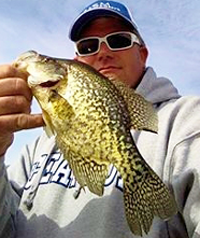
Chad Peterson with one of many catch and release fish caught last Saturday.
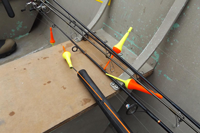
Rocket Bobbers are a key ingredient for successful early season crappie fishing. Heavy yet sensitive, they allow you to cast long distances, covering a lot of water.

Fishing guide Tom Batiuk poses with one of several “doubles” before releasing them back into the Rainy River.
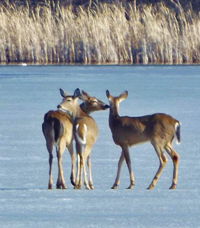 Three young deer wondering how to get off the lake Three young deer wondering how to get off the lake
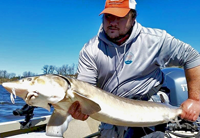
The author, Andy Walsh with a big Rainy River Sturgeon.
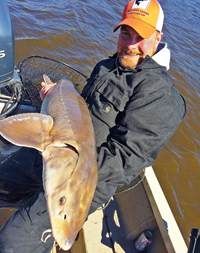
Colby Gallagher displays a big sturgeon from a recent trip to the Rainy River.
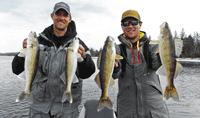
Rainy River Walleyes

Blake Liend playfully poses with some slab crappie.
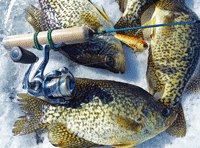
Jigging larger walleye-style baits produced several nice crappie. Pictured is a Salmo “Chubby Darter”
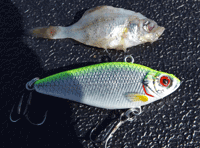
“Match the Hatch”...A Clam “Psycho Shad” closely resembles a small crappie that larger crappie were feeding on.
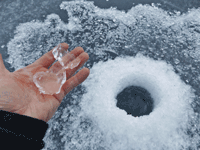
Large chunks of honeycombed ice signals the beginning of the end of another ice fishing season.
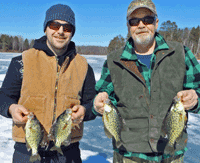
Andy Clusiau teamed up with his father Bruce last weekend for some late ice crappie fishing.

Greg Clusiau;
"I may have started out slow in the catching category but ended up with four of our groups twenty Master fish, with three 28” and a 29 incher."
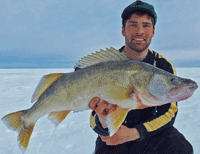
Mike Walsh fished Lake Winnipeg for the first time and landed this 30” walleye.
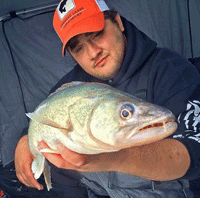
Andy Walsh with a Lake Winnipeg walleye pushing twelve pounds.
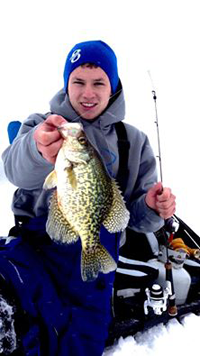
Score! HSM Outdoor’s Tyler Mohr volunteered his time for the “Fishing with Vets” outing and caught some beautiful crappie.
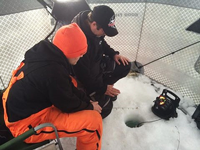
Crappie Coach...Crappie Keith Nelson explains proper use of a Vexilar to one of the veterans.
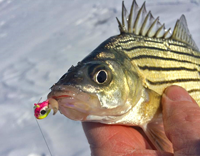
Clusiau calls the Yellow Bass "A feisty, aggressive little fish that
just looks so darned cool."
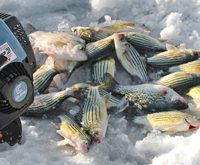 “Yellows”, an invasive species, taste great, and there is no limit. Think about it. If you’ve got a hankering for a fresh fish dinner and live fairly close to Clear Lake there’s absolutely no reason not to have one. “Yellows”, an invasive species, taste great, and there is no limit. Think about it. If you’ve got a hankering for a fresh fish dinner and live fairly close to Clear Lake there’s absolutely no reason not to have one.
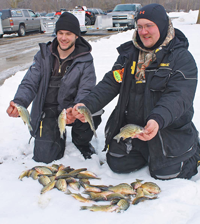 Schuttler and Lauber display their winning catch of 50 yellow bass weighing 15.14 pounds. Schuttler and Lauber display their winning catch of 50 yellow bass weighing 15.14 pounds.
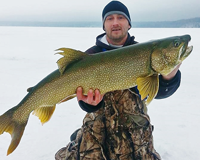
Lee Lane shows off a great, Burntside Lake Trout
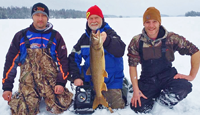
Flow North Outdoors; Based out of the Effie-Bigfork area, the duo makes several trips each winter to this 7,139 acre Canadian Shield fishery located near Ely and seem to have it “wired.”
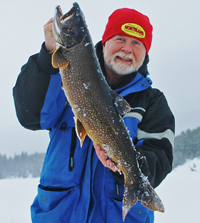
Greg Clusiau showign off another great Laker taken on Burntside Lake.
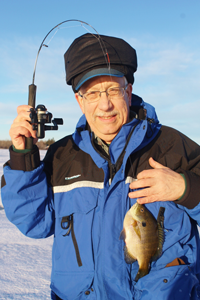
Raymond Jensen, Chisholm, enjoyed a great day of panfishing last week, catching bluegill, crappie, and jumbo perch.

Seth Weber, Taconite, caught this nice northern pike while trying for the big one he saw the day before.
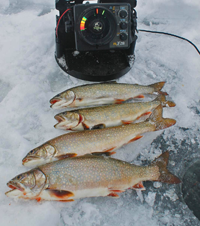
Happy with his catch of Rainbow Trout on the Minnesota Trout Fishing Opener, Greg Clusiau says; "It’s your job to keep your eyes open and be ready to present a lure that is of interest to them. You have to be on your toes."
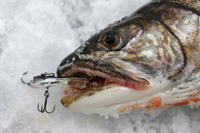
|
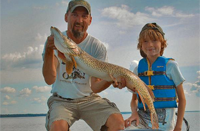
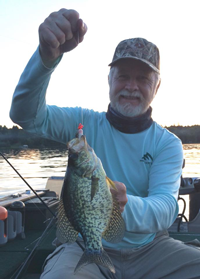
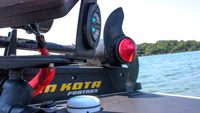
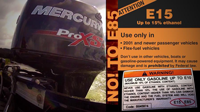
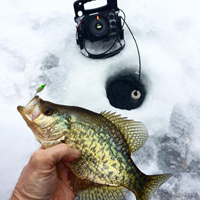
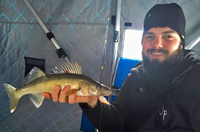
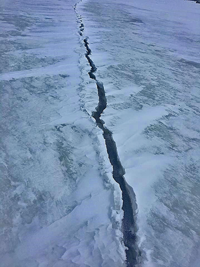
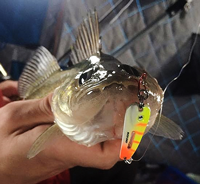
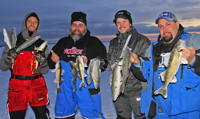


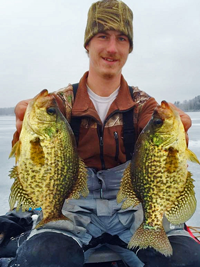
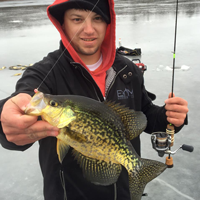
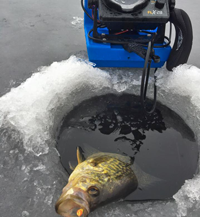
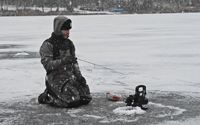
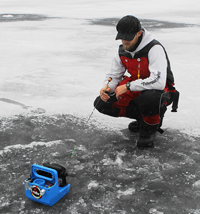
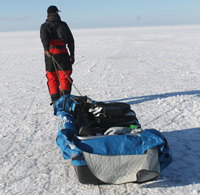
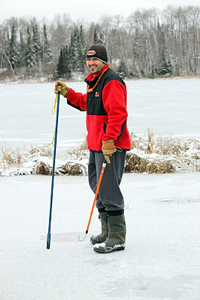
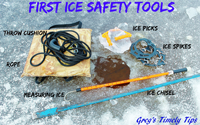
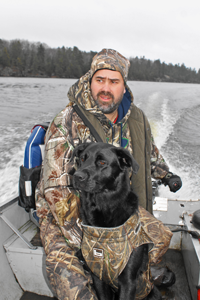
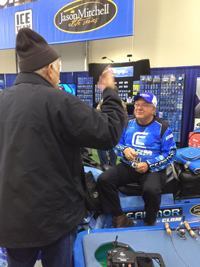
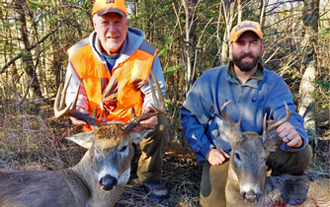
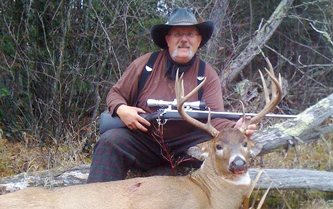
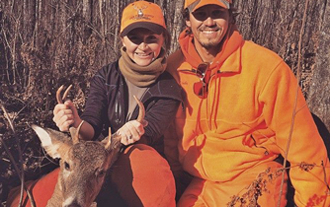
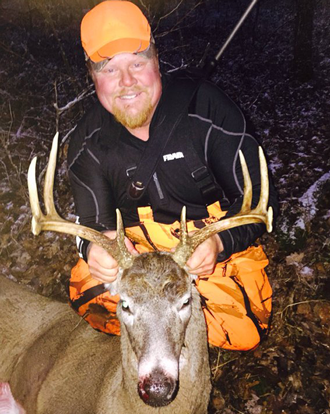
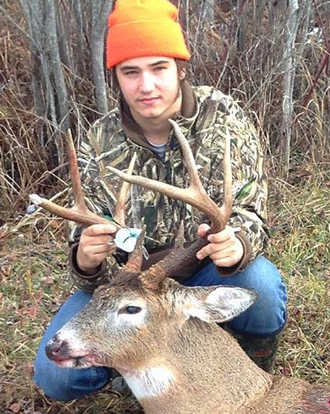
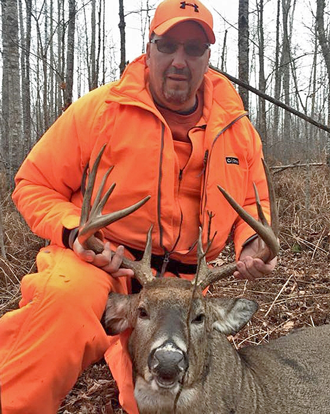
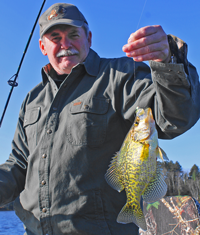
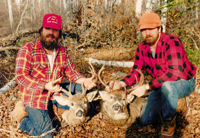
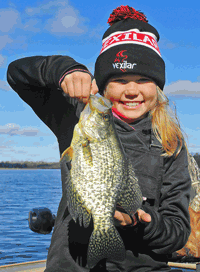
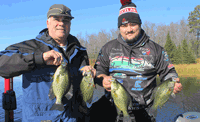
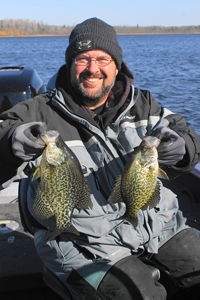
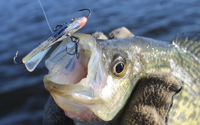

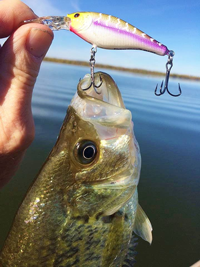
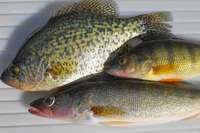 Yes, the fall fish migration is well on its way and things are happening.
Yes, the fall fish migration is well on its way and things are happening.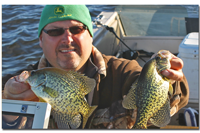
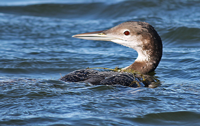
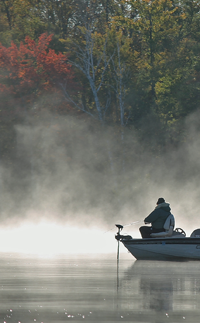
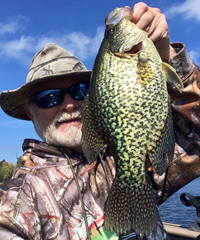
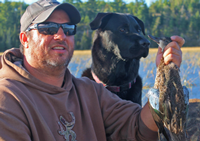
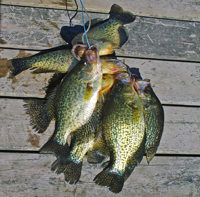
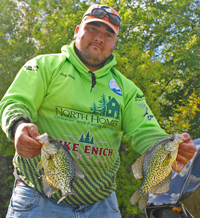
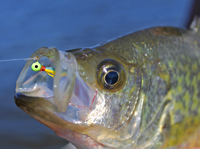
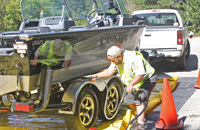
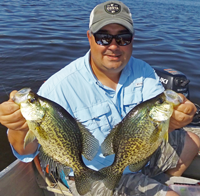
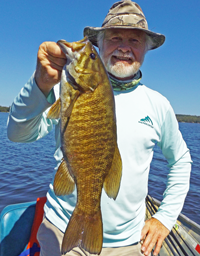
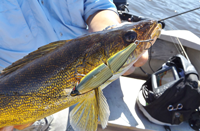
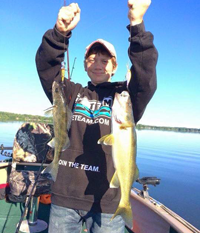
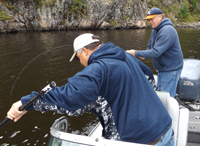
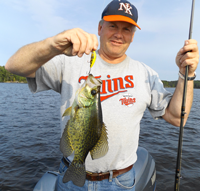
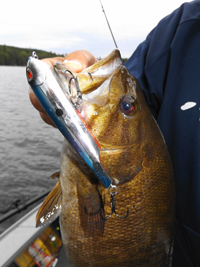
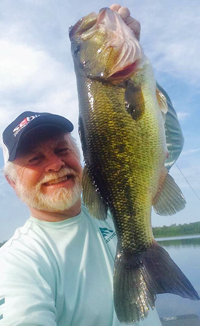
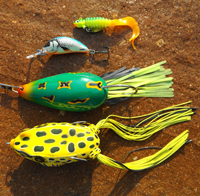
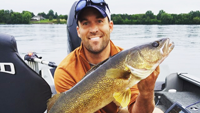
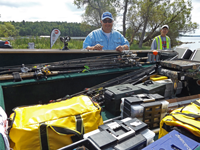
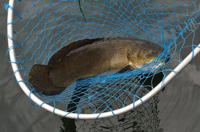
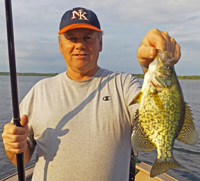
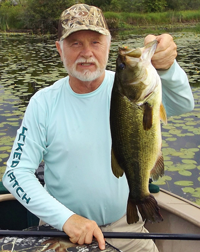
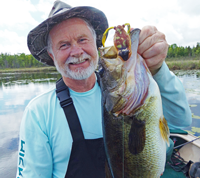
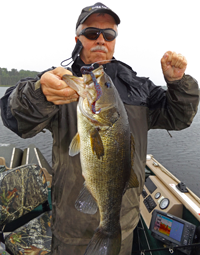
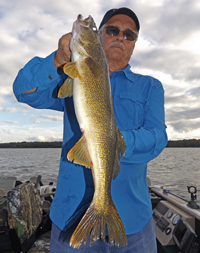
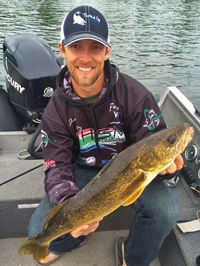
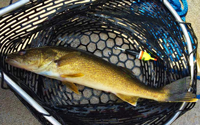
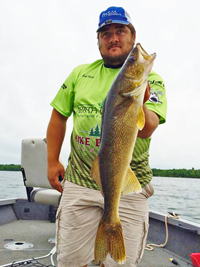
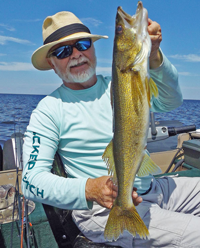
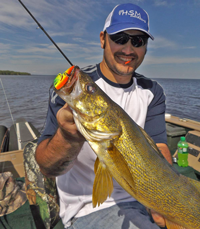
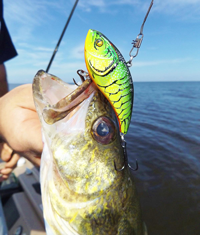
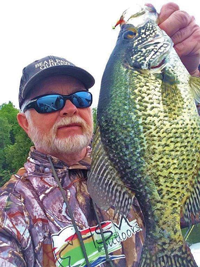
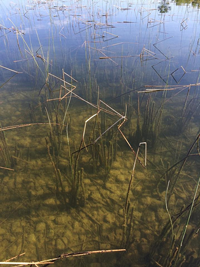

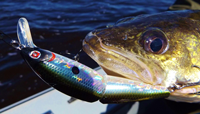
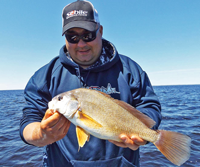
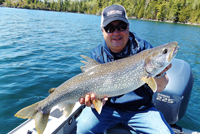
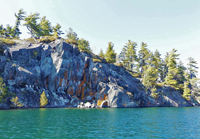
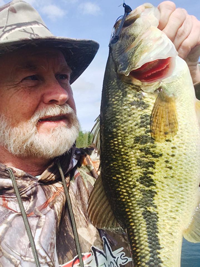
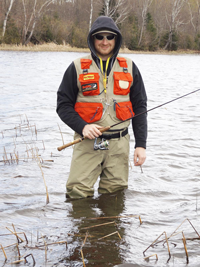
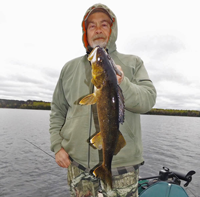
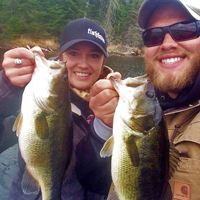
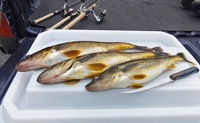
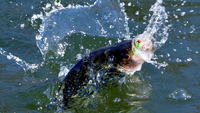


















 “Yellows”, an invasive species, taste great, and there is no limit. Think about it. If you’ve got a hankering for a fresh fish dinner and live fairly close to Clear Lake there’s absolutely no reason not to have one.
“Yellows”, an invasive species, taste great, and there is no limit. Think about it. If you’ve got a hankering for a fresh fish dinner and live fairly close to Clear Lake there’s absolutely no reason not to have one. Schuttler and Lauber display their winning catch of 50 yellow bass weighing 15.14 pounds.
Schuttler and Lauber display their winning catch of 50 yellow bass weighing 15.14 pounds.






